What The Cost Of Living Means For Flexible Working
19th Jan 2023
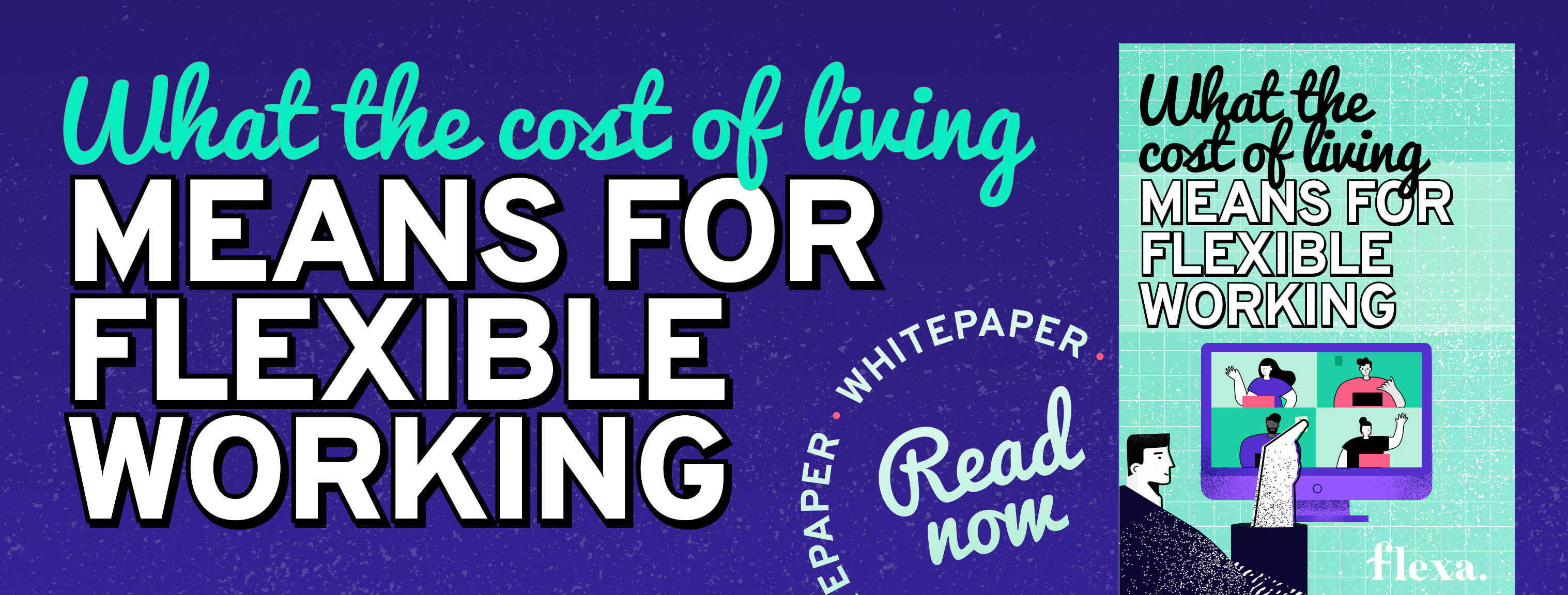
Flexible working and the cost of living crisis aren’t two things that you’d generally put together. However, the factors surrounding people’s desire for flexible working are complex and interwoven, so naturally, the current economic situation will have an impact on the way we work.
In this white paper, we will explore the relationship between flexible working and the cost of living crisis, as well as the recommendations for companies looking to adapt fast to this rapidly changing environment.
Cost of living crisis - what is it?
Due to compounding economic forces resulting in high inflation, the cost of everyday essentials such as food, bills and fuel, alongside other necessities, are rising faster than the average household income. Both employers and employees will be searching for guidance and support for the coming months/years.
How will it affect employers?
Costs will be higher, budgets will be lower, and many businesses will be impacted by decreasing disposable income of consumers, or tightening budgets of B2B customers. In addition, the uncertain and rapidly changing talent market presents additional challenges (see the Great Reshuffle) around employee engagement, productivity, and talent attraction.
How will it affect employees?
Employees are looking for higher salaries to manage increased costs, with two-thirds of businesses seeing requests for pay rises increase. On the other hand, many are anxious; with the potential for unemployment on the cards, we’re seeing the effects of this already with the increase in redundancies; it’s predicted that 1 out of 5 employers will likely make redundancies over the next year.
Businesses are unlikely to be able to afford an increase in salaries without putting themselves and their employees in jeopardy, they have to think critically and strategically to avoid creating a hyperinflated market which puts the economy in more danger. The increase between inflation and wage growth has been rapid (as illustrated by ONS) and it’s unlikely that wage growth will be able to keep up with inflationary prices, as the previous growth has been unsustainable.
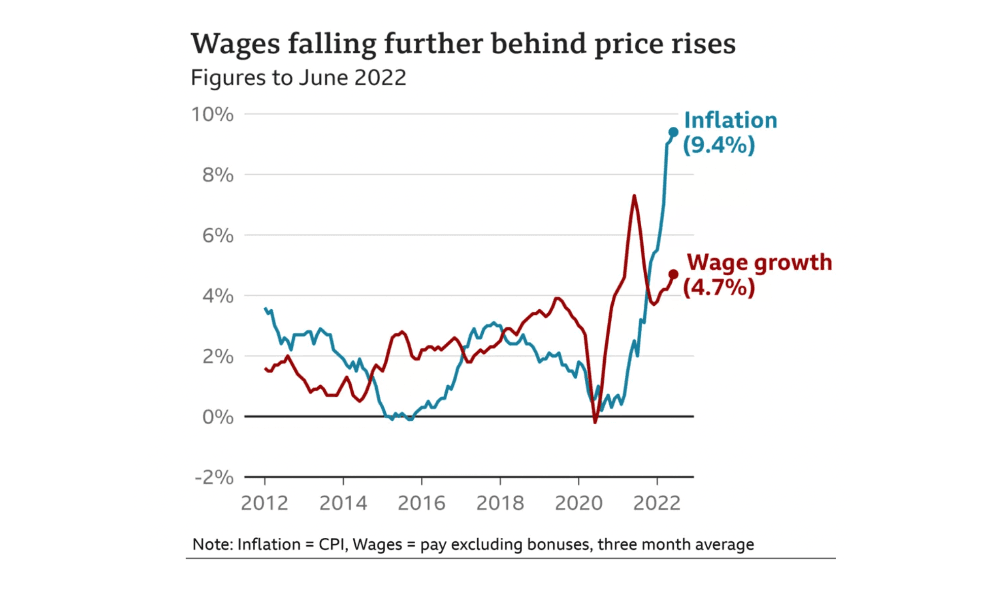
With inflation expected to remain at levels previously seen only between 2010 and 2011 for the next year or so, spending habits will be impacted. 66% of adults are already spending less on non-essentials according to the ONS people trend survey.
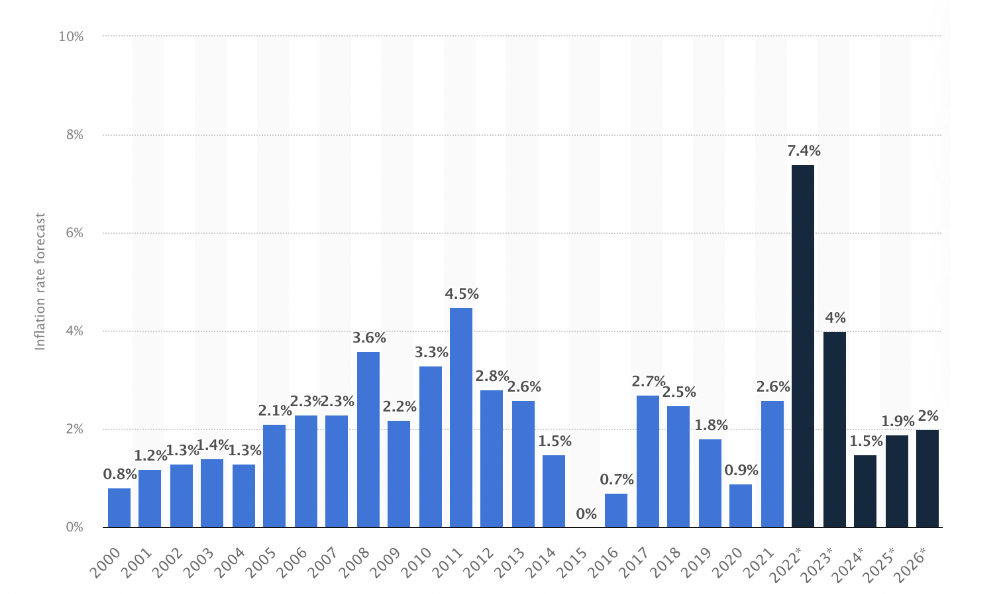
How does inflation affect pay?
Sadly, pay does not follow inflation.
Inflation is a general increase in prices for goods and services when purchasing power decreases.
Pay is the money that you receive from your employer. Your salary will be dependent upon the industry and the role you work in, whilst being based on supply and demand within the market.
Then there is hyperinflation which is caused by a surge in prices for essential goods - creating a market where demand outpaces supply.
The past three years have seen rapid salary growth in some areas, but this growth is unlikely to continue as inflation rises. Finally, as businesses come under pressure in a difficult macro-environment, continuing to increase pay will put the future of that business, and employees' jobs, at risk.
So, what else can employers do to ensure that their employees are happy, that won’t involve huge pay rises? Let’s take a look at flexibility in the three areas that people have reported would have the biggest impact on them most - remote-first, flexible hours, and dog-friendly offices.
How the cost of living crisis is affecting demand and supply for flexible working - an analysis of our data
How has this impacted the demand for location flexibility?
Firstly, let's look at the different types of working arrangements:
- Fully remote work (no office) - means working fully-remotely with no office location.
- Hybrid - is a mixture of in-office and remote work, this could look like working 3 days from home and 2 days in the office.
- Remote-first - is often misinterpreted as a hybrid work arrangement, but they are very different. Remote-first is first and foremost a remote team but there is an opportunity for employees to work from the office if they wish. Employees may also need to come to the office for company meetups or training during the year.
Data collected on the Flexa platform shows the demand for fully remote work has decreased over time; this coincides with the increase across searches for remote-first roles.
People are favouring choice over one set option. Based on our research, this is due to the desire to balance freedom with other needs. The top three reasons, are:
- Electricity costs - heating your house all day is expensive, and offices are generally heated.
- Collaboration - after two years of forced fully-remote working, people are seeking more in-person, collaborative time. In addition, the increasing anxiety that people are feeling due to increasing costs can leave people feeling lonely, and having company can alleviate this.
- Work-life balance - sometimes a change of scene is good for keeping work and life a bit separate when things feel like they are getting too much.
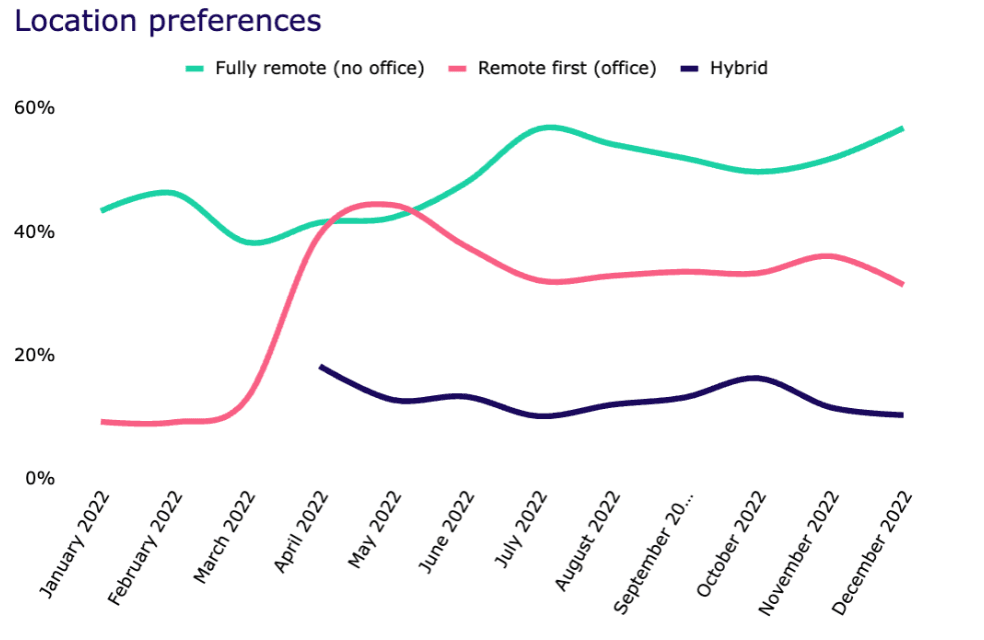
The demand for fully remote companies has increased, but supply isn’t keeping up, as only 38.4% of companies on Flexa are remote-first. Employers can seize this opportunity by offering the option of an office or co-working space.
How has the cost of living crisis impacted the demand for flexible hours?
Working a non-linear workday can help employees to balance other demands, such as picking children up from school, walking the dog, and balancing the demands of the rising cost of living.
In addition, flexible hours that enable people to juggle work and life mean that a greater proportion of the population can be economically active, and increase household incomes overall.
Around 50% of candidates are searching for employers who offer flexibility around working hours. This ranges from totally asynchronous, through to core hours. Employers are now offering more flexibility with hours - data from Flexa shows that the number of roles with ‘flexible hours’ shot up by 55% (between September and October 2022) - up from 22% to 34%. And here is where we are now…
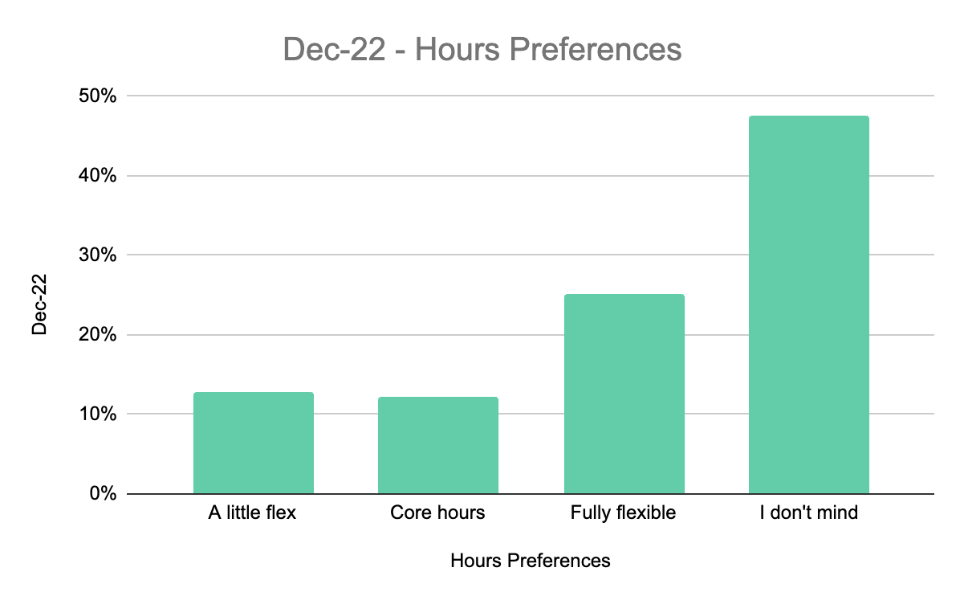
What about our animals?
In the UK, 34% of households own a dog. In the US, 63.4 million households have dogs and, over the pandemic, about 30% of Americans adopted at least one pet. The number of UK households now owning a pet is at an all-time high. The average cost of putting your dog into doggy daycare is £30-£40 per day, by enabling employees to work from home sometimes, and bring their dog into the office when they come in, companies can help to prevent that additional expenditure.
Data from Flexa over a 3-month rolling average show that 20% of candidates searching for new roles are looking for jobs with dog-friendly offices (in fact, it’s one of the most popular benefits). Whilst pet owners can also benefit from other flexible working arrangements such as fully remote or remote-first for more flexibility, people appreciate having the option to bring their dog into the office on occasion to save on doggy daycare. It’s also a fantastic morale booster!
We’ve spoken to a couple of Flexified companies to shed some light on why dog-friendly offices have been beneficial to them.
Chris Woods - Employer Reputation and Recruitment Marketing Manager at Mars UK
“As an owner of a very demanding sausage dog, not having flexible working would make life infinitely tougher. Sausages are notorious haters of the rain so even simple things like being able to take him out on a walk at the drop of a hat without feeling guilty about it, or needing to take him to the vet should something happen, having the flexibility to do that, and know I don’t have to worry about work makes the biggest difference to my mental health. Having pets is such a huge part of so many people’s lives, that pet benefits make sense now, and are such a great way to attract and retain talent, and happy talent at that!”
Michelle Wood - HR Business Partner at Sift
“I believe having a dog-friendly office is great for staff morale, our people love it when we have a dog join us for the day and the dogs get showered with attention”.
“For me, dog-friendly offices have so many benefits. The first is the most obvious, who doesn’t love a dog?! On a more serious note, having the dogs in the office really helps reduce stress, and being a sense of calm to an office, they’re also great at making sure people are getting up out of their chairs semi-regularly and getting out for some fresh air. Taking the dog out in between calls really helps me switch off for 5 minutes, and de-stress before my next call. It also removed the stress of leaving the dog at home for long periods of time or the cost side of having to get a dog walker in during the day to make sure they’re not alone – being able to bring them along makes life so much easier when we do need or want to be in the office to connect with colleagues.
So, why should the cost of living matter to companies?
A third of employees have considered a job move due to the cost of living, with 65% of people stating that salary is their main priority when looking for a new role. Businesses, however, might not be able to keep up with inflationary pay rises, thus will struggle to attract and retain employees whilst maintaining engagement and productivity.
79% of employees have stated they want employer support through the cost of living, with 71% feeling that their employer hasn’t adequately kept up with the cost of inflation.
When asked what percentage salary increase they would expect if handing in their notice and negotiating a pay rise, 25% wanted a 9% to 10% salary rise.
Meanwhile, 31% would be less likely to leave if their employer offered flexible or hybrid working schemes.
As discussed, raising salaries isn’t necessarily an option. However, there are other ways to accommodate employees in this new age of uncertainty.
So, what can companies do?
Provide access to co-working spaces
Coworking spaces are a brilliant solution for all companies, whether they are fully-remote, remote-first, or hybrid. Whole teams can come together and collaborate, or individual employees can settle down and focus.
It’s this versatility that keeps things fresh for employees. Different tasks ultimately deserve different spaces — no one wants to sit in the same chair for every task they work in — and the breadth of coworking spaces out there today means employees can pitch up in their perfect workspace, wherever and whenever they please.
The home isn’t always conducive to the best work. Whilst it can be good for deep work when you’re comfortable and free from distraction, it can also become too comfortable. We all know how good a trip into the office can be to shake things up, top up the productivity tank, and make you feel part of the company culture. Also, today, with energy costs spiralling, it may be harder to focus and perform in a cold house. But, as we know, circumstances and preferences are different and employees place the most value on having the choice to decide where they work.
Expensive office leases are immovable costs that remove flexibility from budgets. Coworking spaces can be used as a hub for employees to meet once a week, or once a month, or they can also be used to complement a smaller, and less costly, office.
This means those planning on making redundancies to cut costs right now could actually cut costs more effectively by reducing office spend. Imagine that, still having an office and the same group of talented employees on board!
We know, some companies may not want to strictly work in coworking spaces. But today, it’s possible to have a full-time office on a flexible contract and give employees on-demand access to coworking spaces and other flexible workspaces.
“Hubble makes it easy to facilitate coworking (and control your office spend) by bringing everything under one roof. You can take a full-time office for as little as one month, and receive complimentary access to coworking spaces, meeting rooms and private day offices across over 800 locations globally. You can have your cake and eat it – saving money and keeping staff happy.”
Will Langston - Content Marketing Manager at Hubble
Offer mental health support
We all experience mental health issues from time to time and 25% of us will experience a significant struggle with our mental health that will impact on our ability to live our lives (at work and away from work). When employees are not feeling well then they are going to struggle.
It can be exceptionally challenging for employees to find good mental health care. Waiting lists are long, and the standard of care can be poor. Therefore, there is a significant opportunity for employers to support their employees’ mental health by providing access to mental health support.
The cost of living and reduced disposable income is an upstream factors that can impact on decisions that an employee might make (exercise, socialising, engaging with leisure pursuits, culture, travel for pleasure etc). Downstream, this will negatively impact on their mental and physical health. The longer the cost of living crisis goes, the more extreme the downstream consequences will become - e.g. ability to afford good housing, good diet, heating etc.
- 1 in 5 say that their employer is not doing enough to support them in relation to the rising cost of living
- More than a quarter of employees say that their pay is not enough to cope with a £300 emergency bill (car breaks down, heating breaks down, etc).
- 1 in 4 say that worry about money affects their performance at work
How can mental health support benefit employees? From Sarah Bateup, Chief Clinical Officer at Oliva
- Quick access to high quality mental health care
- Employees feel psychological benefit of having a safety net - "someone is there to help me if I need it"
- Less absenteeism
- Attracts and retains staff
- Sense that the company really cares (providing that it's not a tick box exercise)
- Managers have less 'managing' of mental ill health and can hand it over to the experts
- Peers are less impacted by a colleague's mental health
- Prevention of mental health disorders - proper mental health care does not necessarily mean 25% of people are in therapy all the time - we would expect that at the beginning but over time proper mental care supports people to stay well.
Provide benefits that employees actually want
Offering employee benefits or revamping your current perks can help to retain your best talent, and help employees manage day-to-day costs.
A report by MetLife UK, surveying 1,200 employees and employers, found that 50% of workers would accept a reduction in pay for more tailored perks, whilst 74% of employees said they would work harder for an employer that provided benefits to support individual needs.
So, what benefits can you offer? We’ve listed some of the top perks that employees are looking for:
- Dog-friendly offices
- Subsidised gym membership
- Health plans that let employees claim money for opticians, dentists, physio, and more
- Private health insurance with 24/7 GP access
To take it a step further, there are companies like Perkbox that help employers find tailored, meaningful benefits that employees will actually use, giving choice to employees on what benefits they’d like to receive. This means no wasted budgets and happier, healthier, more engaged employees.
Gautam Sahgal, CEO, Perkbox
“The days of having a one-size-fits-all approach to your benefits package are long gone. People get choice in almost every other aspect of their lives, so naturally they want and expect this from their benefits as well. Employers need to show they see them as individuals, and not just a number — especially during a cost of living crisis where everybody will have their own challenges.
Many organisations will have up to four generations of employees — and their workforces will become more diverse through the rise of borderless working. We actually conducted research which showed that 62% of UK businesses will be hiring remote staff outside their main country of operations in the next year. This brings many opportunities, but also increases the importance of offering meaningful benefits.
This isn't simply a short-term trend either. The next generation of employees will place even more value on this — in fact, a separate study we conducted of Gen Z workers saw 87% say it was important that benefits were tailored to them”
Introduce non-linear workdays
These are workdays that allow you to move between work and non-work time on an asynchronous schedule enabling employees to do their jobs outside of the rigid 9-5 - without needing to account for paid time off.
This offers ultimate flexibility for people to manage their workday with their personal life. It’s particularly helpful for those with caring responsibilities and the associated costs that come with that.
A McKinsey study of 13,382 global workers showed that 40% of people said workplace flexibility was their top motivator for whether they stayed in a role. Offering diverse and inclusive work arrangements makes a company more attractive to employees, providing greater autonomy and trust. Failing to recognise and adapt means that companies could lose some of their best talent and may find it difficult to hire in the long run.
Focus on an output-driven culture
Performance management hasn’t yet adapted to the new world of asynchronous, remote, and flexible working. The age-old fall back of assuming that long hours means high performance has been disproven, but many businesses are still struggling to adjust to measuring performance that isn’t based around presenteeism.
Our CEO, Molly Johnson-Jones, explains that: “This can come in the form of OKRs if you’re looking for more structure, or create a culture that affords someone trust to get their role done autonomously from day 1. It is better to give someone your trust and the freedom to prove themselves, rather than micromanage them so they can’t break your trust because you are afraid of what will happen. In fact, “trust and autonomy” was the third most important factor (behind location and hours) when we asked our users what flexibility meant to them. When people are given greater autonomy in their work, they are less stressed, happier, and perform better.”
Rather than focusing on measuring by hours spent at a desk or screen, performance should be measured around output and results - which takes into account where employees work their best.
Otherwise, you could end up losing your best talent and end up with higher costs associated with recruitment and training during an already financially difficult time.
Clear communication
Great communication is essential in any business, particularly in the current climate and even more so important when teams are dispersed geographically. There’s a fine balance between over-communicating and leaving employees in the dark.
Having said that, we know that regular and detailed communication truly underpins good management. Communicating your recession plans is particularly critical to ensure that all employees can be aligned with company targets/goals to survive the economic downturn.
After all, a company is a collection of people striving towards the same goal, so goals need to be clearly communicated across teams to ensure that everyone comes together to weather this storm.
What does the future of flexible working look like as a result of the cost of living?
The costs of working at home are at the forefront of many people’s minds, yet the love for workplace flexibility remains high. Due to higher household costs i.e. gas and electricity, employees are looking for alternative options to working from home every day - whether that be having options to work some days in the office or a co-working environment.
So what will the future of work look like? We’ve put together our predictions on what the next 6 months will look like in terms of the types of working environments people will be searching for during the cost of living crisis.
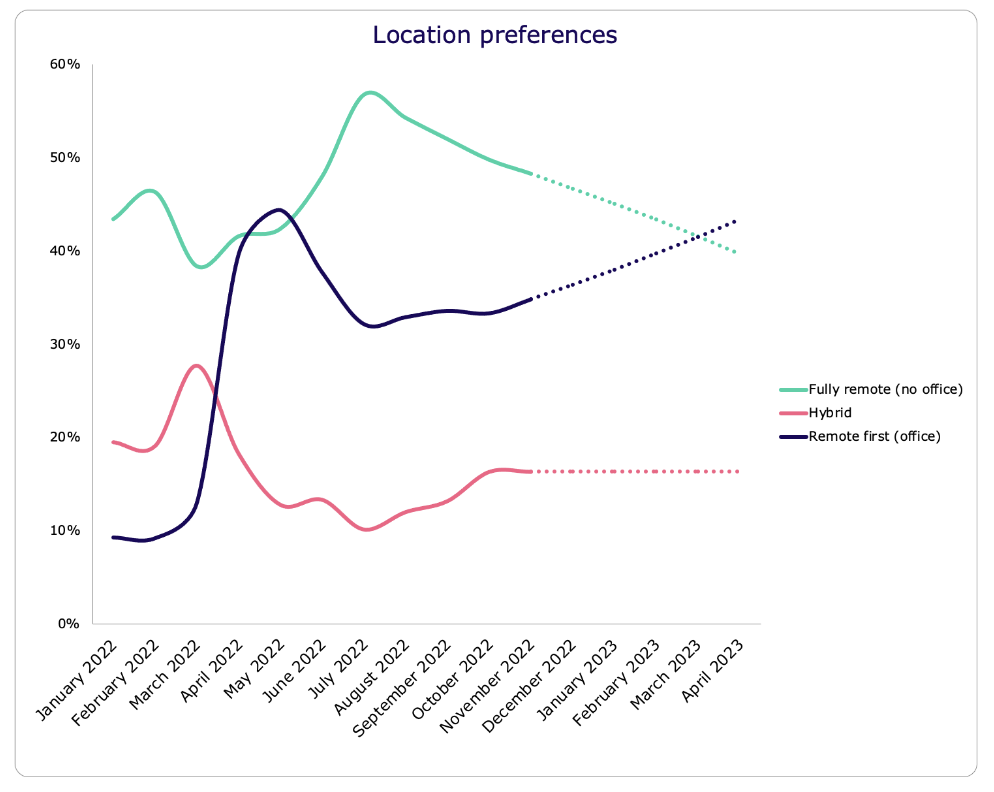
Hybrid working was a popular option at the start of 2022, although it did see a decline mid way through the year. Over the next 6 months, we don’t expect much movement and predict figures will remain flat around 17% with fully remote and remote first being the more favourable working arrangement.
Fully remote became the most popular choice across spring/summer when people like to travel and enjoy more freedom in their working environment. Since the summer, the demand for fully-removed companies has declined. We do expect further decline over the next 6 months as individuals look for opportunities that afford them choice over where they work.
We predict that remote-first will be the most favourable working arrangement over the next 6 months and beyond, and this all comes down to choice. Choice gives employees more control over their environments, as as we enter into a recession straight after coming out of a pandemic, control will be key to managing conflicting demands and helping people to feel more in control of their lives.
Likewise, the most cost effective and preferred option won’t be the same for all. The key takeaway is that candidates/employees favour choice above all else in order to make a decision on what is best suited to their needs.
What does this mean for the future?
For companies, it’s important to be clear from the offset around the kind of working environment and culture you have to offer. Doing so will enable you to attract well-matched candidates and help employees to thrive, all whilst reducing training costs associated with higher employee turnover.
Companies also need to consider the type of working environment they currently offer and how they will adapt over time. Millions of people are already leaving their jobs in search of more fulfilling roles offering greater freedom and workplace flexibility - this phenomenon has been dubbed “the Great Reshuffle”.
Over the next 2-3 years, an increasing proportion of people will search by “how” they want to work, leading them to perform job searches “company-first” rather than “role-first”. So, companies must lead with their working environments and enable people to make an educated decision about whether your company is the right place for them.
With this in mind, individuals want flexibility, freedom, and choice that offer an improved work-life blend. Companies that can align with this will be able to attract and retain the best talent and have better performance and productivity, even more so at a time when salaries cannot keep up with inflationary prices. As an employer, you’ll be amongst those who have something else to offer - not just now but in the future.
“There has never been a better time to shake up your hiring strategy. Companies that showcase their flexible working environments will win the war for talent, and acquire that talent quicker, and cheaper, than their competitors. If you’d like to find out how you can start doing that with Flexa, then please take our quiz to find out whether you’re offering a working environment that can do the heavy lifting for your employer brand and hiring”
Molly Johnson-Jones, CEO and Co-Founder of Flexa.